Due to the impact of these on-chain states and logics, Web3 games will have a deeper sense of immersion and longer-lasting vitality than Web2 games.
Author: 1kx
Translation: Meta Era 237
From a historical perspective, each new computing paradigm has unlocked a series of new possibilities for games:
- Transistors / microprocessors / television - the concept of computer games
- PC - expansion of game categories to include strategy games and simulation games
- Internet - multiplayer online games
- Social networks - social network games
- Mobile devices - casual games
- VR - spatial domain games
With each new chapter of change, we can see new teams succeeding by adopting new patterns and technologies. It is not traditional companies, but emerging thinkers - game designers who can provide users with new experiences using the new features provided by each computing medium. This has also happened with the active pioneers of Web3 games, each innovating in their own way.
- In 2017, Crypto Kitties created the first encrypted game, allowing players to collect and breed new kittens.
- In 2018, Axie Infinity put assets on the chain as NFTs and created an open and fluid SLP economy.
- In 2020, Dark Forest combined zero-knowledge proofs with on-chain game logic to create the first on-chain game that can hide information, has no entry barriers, and is scalable.
- In 2021, the Loot Project was released, becoming a symbol of foundational layer IP that people can expand without permission, giving rise to hundreds of games and applications that integrate Loot into gameplay and storylines.
- By 2023, a new type of full-chain game / autonomous world as a new industry is rapidly developing.
Through continuous experimentation with on-chain games, we have discovered the new experiences brought by on-chain assets, game states and logics, permissionless expansion, and composability, pointing us towards the possibilities of the next generation of encrypted platforms, namely autonomous worlds. At 1kx, we believe we are in the process of the next generation of games - from 0 to 1 of on-chain games.
What is an Autonomous World / Full-Chain Game?
Let's borrow the definition of native encrypted games (excerpt) from gubsheep:
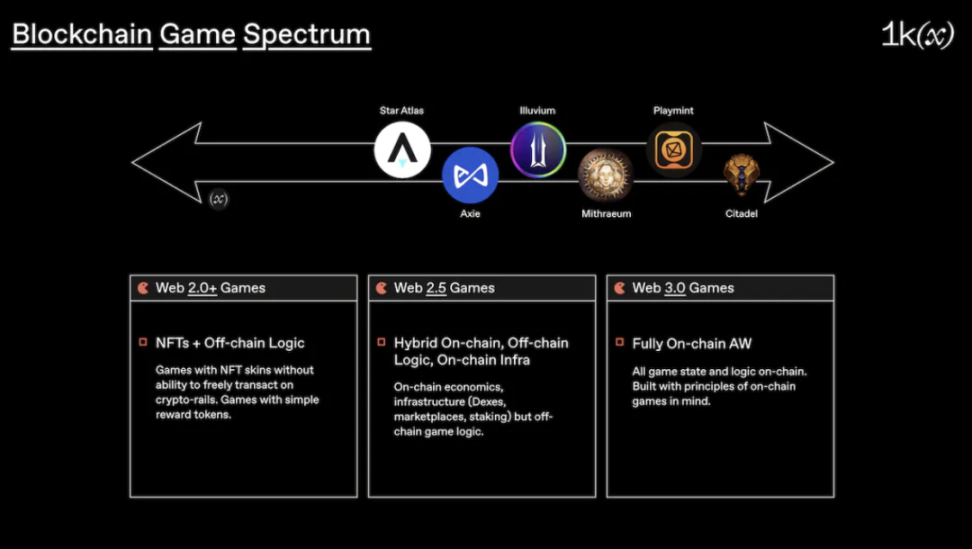
Full-chain games have the following characteristics:
- All game logic, states (assets and others) are on-chain, implemented through smart contracts.
- The true source of game data is the blockchain. The blockchain is not only used as auxiliary storage for data or a "mirror" of data stored in proprietary servers, but all meaningful data (not just asset ownership) will be stored on the blockchain. This allows games to fully utilize the programmable advantages of the blockchain: transparent, permanent, and permissionless interoperable data storage.
- Games are developed according to the principles of an open ecosystem.
- Game contracts and (usually) accessible game clients are open source.
- Third-party developers can deploy comprehensive customization and forking of new game experiences through plugins, third-party clients, and interoperable smart contracts. Conversely, this will allow game developers to leverage the entire (incentivized) community for creative output.
- The game is independent of the client (frontend).
We often see in the literature of full-chain games that the "autonomous world" or equivalent "on-chain reality" is isomorphic to this model in the following aspects:
- On-chain game states, where the blockchain is the true source of game data and "world" states (consider the situation at any snapshot in time).
- On-chain game logic defines how players interact with the game, while the physical rules of the real world define how people interact with reality.
- Emphasis on the principles of an open ecosystem and other variable elements of the foundational layer, as well as community and governance structures in the form of citizens and governments.
This world is "autonomous" because:
"A world with a blockchain base can almost achieve maximum autonomy: anyone can introduce rules without compromising its objectivity. The disappearance or betrayal of any specific individual will not harm the world: its narrative boundaries remain as hard as iron walls." - Lattice
Autonomous World as the Vanguard of the Next Era
Two transformative unlocks make the autonomous world highly attractive:
- By putting game states and logics on-chain, behaviors within it have real economic incentives, and players will pay more attention to their on-chain game behaviors and be willing to experience deeper immersion and unlimited participation. The censorship resistance of on-chain games will allow this immersion to grow without platform risk. Running on public blockchains also means that games can exist indefinitely.
- By allowing anyone to extend or modify the game, on-chain games encourage development, better aligning the interests of modifiers and game developers, and allowing players to control the normative game experience, moving towards an interoperable metaverse.
On-Chain Game States and Logics (and Open Source)
On-chain game states and logics will enable:
- Inheritance of permanence and fault tolerance as underlying properties of the network. Actions, asset ownership, and qualifications obtained in the game are incorruptible, verifiable, and permanent. At the same time, the game and its surrounding ecosystem will also have censorship resistance.
- Stakeability. Assets essentially have monetary value because they can be traded (if not NFTs, then in the private key market). Achieving state transitions requires gas consumption. This means that participating in on-chain games will have real economic impact and often bring unlimited economic upside.
"We must also remember that transactions cost money. Therefore, the most effective way is to give strategic meaning to any transactional behavior in the game. This means that players should strive to put as much intellectual work as possible into a transaction." - Bohdan from Mithraeum
Due to the interaction of these traits, we speculate that players of on-chain games will establish a deeper and more immersive relationship with the autonomous world for the following reasons:
Stronger sense of ownership of in-game assets and achievements. We have already observed people building digital identities around on-chain behaviors and achievements, such as degen scores, wallet analysis, game leaderboards, and C4. This is also the case in high-value economies and item games in web2, where players spend thousands of hours and tens of thousands of dollars to obtain rare items in the game and build communities around their ownership. True ownership of assets and achievements will amplify this sentiment. As evidence, we see Dark Forest NFTs (NFTs obtained by winning Dark Forest rounds) being sold at historically significant prices despite having no functionality/utility.
Stronger desire to master the game to obtain high-value assets and titles. We see players in Dark Forest building robots, monitoring tools, and custom clients to climb the leaderboards. We also see communities closely linked to their high-value PFPs in web3.
No need to worry about platform risk: In Web 2, many game modifications and auxiliary platforms have been issued stop and ban notices by their parent IPs. Leaving aside regulatory arbitrage, on-chain censorship resistance, permissionless deployment, and tolerant open source licenses/culture ensure that on-chain games and their surrounding ecosystems cannot be arbitrarily shut down.
In summary, we speculate that due to the impact of these on-chain states and logics, web3 games will have a deeper sense of immersion and longer-lasting vitality than web2 games.
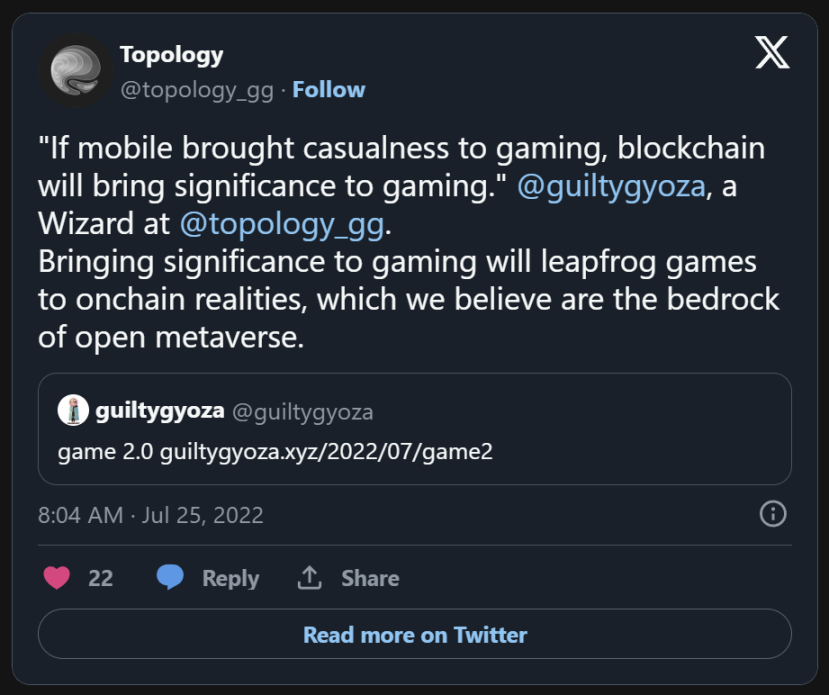
Autonomous World as a Permissionless Platform
The history and development of games are closely related to modding. Many groundbreaking games initially emerged or became popular as mods of popular titles. There is a wealth of evidence to suggest that players want to participate in the development of their favorite games, and often end up creating experiences that are equally liked by others (such as Roblox, Minecraft).
One drawback of the popularity of mods is that, while theoretically they increase the visibility of the product, they may impact the daily active users of the main product. For this reason, and the desire to strictly control IP, strong end-user license agreements (EULAs) and enforcement actions have hindered the growth and monetization of mods over the past two decades.
Recently, games based on user-generated content (UGC) have been seen as a solution because they can capture the value created by the community. Studios can provide creators with tools and a limited set of freedoms to make the process of creating new experiences easier. However, Web2 UGC is still plagued by strict EULAs, high fees, inflexible monetization schemes, and limited freedoms.

Compared to Web2 UGC, the permissionless extension and modification of the autonomous world is undoubtedly a more powerful solution because:
- On-chain game logic defaults to publicly exposing every facet of the underlying game for modification and extension. Any developer can create a series of smart contracts that interact with the game state and logic without having to request limited creative freedom subsets from the game studio (e.g., the ability to create custom maps). This may look like games that read and use the original game state, control the game's results based on the input to the original game logic, and directly call functions on the original game logic, multiple shared states, components, etc.
- The open-source culture and anonymity of smart contract deployment mean that it is almost impossible to enforce traditional Web2 EULAs to prevent mod monetization and control ownership. Modules and extensions deployed on the blockchain have the ability to arbitrarily define value-added parameters (cost of calling functions) and contracts - if decentralized - either have no owner or are controlled by a decentralized entity. This provides the freedom for generated modules to obtain value and prevents the enforcement of EULAs.

Due to restrictive EULAs and the support of insufficient and outdated court rulings, mod creators are unable to apply for copyright for their hard work, cannot easily monetize or control the use of their creations, and cannot easily protect themselves from bad actors' infringement. Even without the restrictions imposed by most EULAs, mods are considered derivative works that do not belong to the scope of fair use.
While mod creators can usually create mods and distribute them for free, they cannot claim ownership of their created mods, nor can they legally profit from their work without infringing on the underlying game's copyright.
There is better incentive alignment between mod and original game creators, and even character fusion can be achieved. While a game's mods may be distributed as a completely independent software, the value flow of on-chain mods can pass through the core game logic of the foundational layer. The more mods and extensions the base game state has, the greater the value of its assets and achievements, and it will also accumulate more value from its supported application activities. This is similar to the incentive structure of NFT IP and L1 blockchains, where developers are encouraged to provide new experiences for NFT holders to accumulate value, or create dapps that increase block space demand.
In on-chain games, each content addition leads to a diversified expansion of playable content. Economic participants and resource accumulators can find new financial opportunities from the imbalance brought by new content. For players who want to play the game, more content means more fun, and for players who want to build/modify the game, they can merge and build new games.
Regarding the permissionless expansion of full-chain games, we speculate:
- We will see explosive growth in game mods and expansion modules (on-chain downloadable content or DLCs).
- Each expansion pack will create more "fun" opportunities for different types of players.
- As long as there is an active community, this cycle will continue. Within the community, there will always be a portion of builders.
- This will lead to games with a truly enduring player base.
- Over time, some expansions and mods will become popular. The game ecosystem itself will become an evolving entity.
To make players' actions in the world meaningful, there need to be positive and negative consequences. Meaningful participation is more attractive than any VR headset. In The Citadel, we hope there are things worth betting on, worth fighting for. We envision a world driven by economic, political, and military competition for scarce resources. The initial game loop revolves around economic competition, but over time, new risks and forms of competition will be introduced.
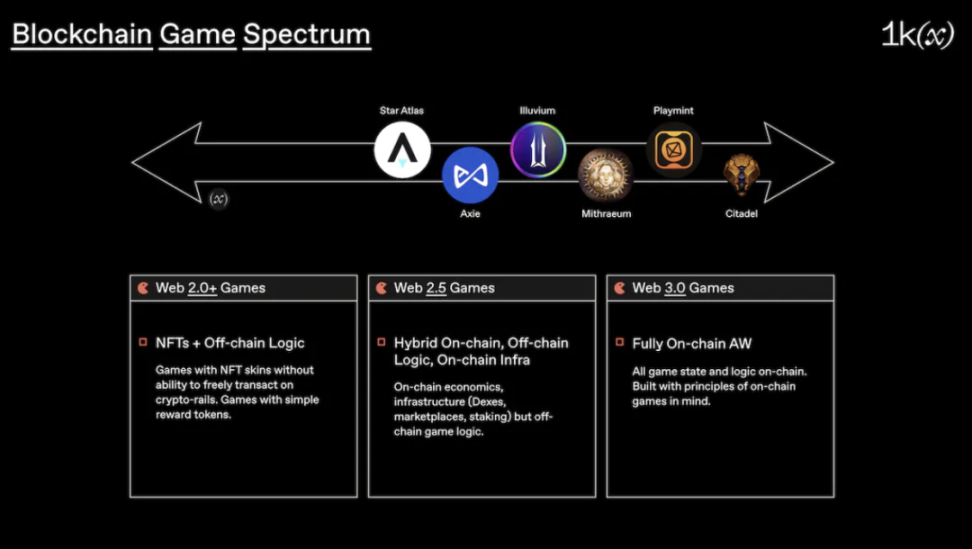
Current State of the Autonomous World
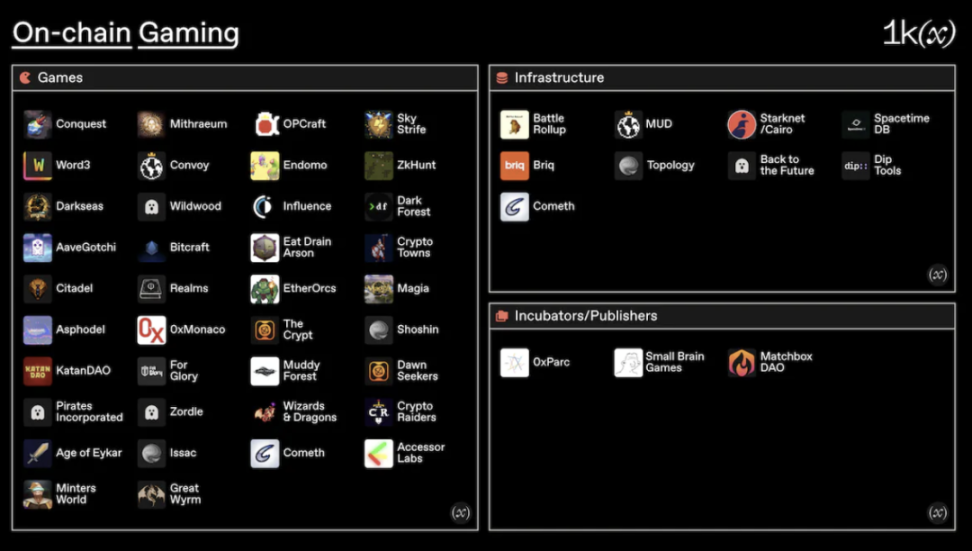
As we can see, many teams are building on-chain IP, infrastructure to make autonomous world development easier, and other development platforms for on-chain games and autonomous worlds.
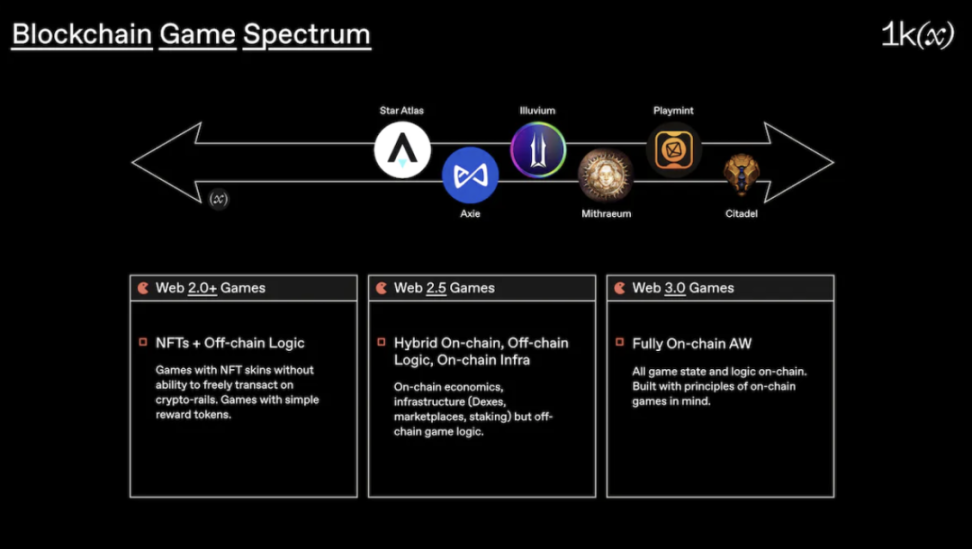
Why We Are Excited About the Autonomous World
Early-stage foundational layer systems - the currently active ecosystems (such as Ethereum) - have many similarities with today's on-chain games:
- Differentiation from existing platforms in technology, enabling new types of applications that did not exist before.
- A strong community gathered around a vision or idea - this vision or idea usually aligns with the differentiating characteristics of the technology.
- A strong initial developer ecosystem of excellent developers attracted to the foundational layer by the vision or idea.
- Widespread questioning of the commercial potential, feasibility, or user-friendliness of these new experiments.
We repeatedly observe the same flywheel pattern:
- The initial community builds very cool and innovative protocols using the computational features of the foundational layer.
- Other builders of these products join the community.
- In thousands of experiments, some key successful applications emerge.
And the autonomous world is at the beginning of this cycle.
The Next Three Years of the Autonomous World
We anticipate the following developments in the coming years:
Explosive growth in playable on-chain games, leading to an explosion in community-driven development based on popular games. Games with the strongest communities will see multiple third-party clients, bots, plugins, and initial experiments in game modules, extensions, and mods that are not forks, but extensions that interoperate with the foundational layer game. At least one such mod will be more popular than the base game.
Permissionless UGC experiments, including games where the output is another game's input, games that share states across multiple different games (thus naturally interoperable), and custom frontends that index different game components and system subsets. Given the availability of open-source implementations of game elements (components and systems), we will see rapid development in this area.
The Autonomous World as the Vanguard of the Next Era
We believe that on-chain games will be the beginning of a new paradigm that permeates mainstream ideology. We see in it the traits of successful networks in the past: complete differentiation from the current state, unique value propositions, energy concentration, and a community of outstanding builders gathered around a vision.
免责声明:本文章仅代表作者个人观点,不代表本平台的立场和观点。本文章仅供信息分享,不构成对任何人的任何投资建议。用户与作者之间的任何争议,与本平台无关。如网页中刊载的文章或图片涉及侵权,请提供相关的权利证明和身份证明发送邮件到support@aicoin.com,本平台相关工作人员将会进行核查。




